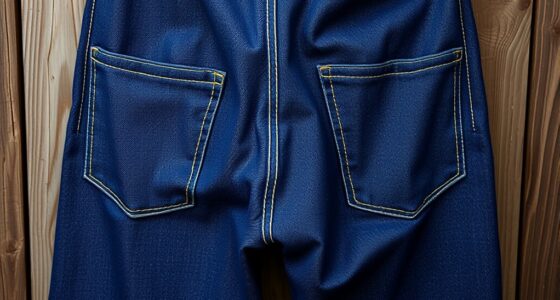To care for your leather, start by identifying its type—vegan, exotic, or genuine—as each needs different products. Gather gentle cleaners, conditioners, and soft cloths, then prepare your item by removing dust and debris. Clean gently, test products first, and apply conditioners evenly to keep leather soft and durable. Store in a cool, dry place away from sunlight. For detailed tips on avoiding common mistakes and maintaining your leather’s look, explore the full guide.
Key Takeaways
- Identify your leather type to select appropriate cleaning and conditioning products.
- Always remove dust and debris before applying cleaners or conditioners.
- Use soft cloths and gentle, leather-specific products for cleaning and conditioning.
- Test products on small, hidden areas to prevent color damage or adverse reactions.
- Store leather in a cool, dry, and well-ventilated environment to maintain its quality and longevity.
Understanding Different Types of Leather

Have you ever wondered why some leather feels soft and supple while others are more rigid and textured? The answer lies in the type of leather you’re dealing with. Vegan leather, made from synthetic materials, often mimics genuine leather but tends to be lighter and less durable. Exotic leather, like crocodile or snake skin, is prized for its unique textures and patterns, but it requires special care due to its delicate, often porous surface. Recognizing these differences helps you choose the right cleaning and conditioning methods. For example, vegan leather usually responds well to gentle wipes, while exotic leather needs more careful handling to preserve its natural beauty. Understanding the specific type of leather ensures you keep your items looking their best longer. Additionally, knowing the materials used can help you select appropriate cleaning products and maintenance routines.
Gathering the Right Cleaning Supplies

Before you start cleaning your leather items, it is essential to gather the right supplies to avoid causing damage. You’ll need gentle cleaners specifically designed for leather, along with soft cloths or sponges. For scratches or color imperfections, consider leather dyeing products that match your item’s hue. If your leather shows signs of wear or minor tears, having leather repair kits on hand can help address these issues early. Avoid harsh chemicals or abrasive scrubbers, as they can strip moisture or damage the surface. Proper cleaning supplies guarantee you treat your leather gently while maintaining its appearance. Having the right tools ready will make cleaning more effective and prevent the need for extensive repair or dyeing later on. Additionally, understanding cleaning and conditioning techniques ensures your leather remains durable and visually appealing over time.
Preparing Your Leather for Cleaning

To guarantee your leather is ready for cleaning, start by inspecting its surface for dust, dirt, or debris. Gently wipe the leather with a soft cloth to remove loose particles, which can scratch the surface during cleaning. Check the leather’s texture; if it feels sticky or stiff, it may need a light dusting or vacuuming with a soft brush attachment. This step also helps identify areas with discoloration or fading, so you can plan for color restoration if necessary. Ensuring your leather is free of surface contaminants prepares it for effective cleaning and helps maintain its natural texture. Proper preparation not only preserves the leather’s appearance but also prolongs its lifespan, keeping it looking fresh and vibrant longer. Additionally, being aware of the leather’s material composition can guide you to select the most suitable cleaning and conditioning products.
Step-by-Step Cleaning Process

Before cleaning, make sure your leather surface is free of dust and debris by wiping it down gently. Gather all necessary supplies like a soft cloth, leather cleaner, and a conditioner so you’re ready to begin. This preparation helps guarantee a smooth, effective cleaning process. Applying a cleaning process after preparation can help maintain the leather’s appearance and longevity.
Preparing Leather Surface
Start by gathering all necessary supplies, including a soft cloth, mild leather cleaner, and a water spray bottle. Before cleaning, examine the leather’s texture and color matching to determine the best approach. Gently remove surface dust and dirt with the soft cloth. If needed, lightly spray water to loosen grime, but avoid soaking the leather. Confirm the cleaner is suitable for your leather’s texture to prevent damage. Test a small, inconspicuous area first to check for color transfer or adverse effects. Proper preparation helps maintain the leather’s natural look and feel. It also ensures that the cleaning process is effective without compromising the leather’s integrity or color consistency. Understanding contrast ratio is essential for assessing how well your projector can render dark scenes and details. Taking these careful steps now will set a solid foundation for successful cleaning.
Gathering Necessary Supplies
Gathering the necessary supplies is the first step to guarantee a smooth and effective leather cleaning process. You’ll want a soft cloth or sponge, a gentle leather cleaner, and a conditioner to restore moisture. To maintain that fresh leather scent, consider using a leather-specific deodorizer or lightly scented cleaner. If your leather has scratches or damage, have a leather repair kit on hand for touch-ups. A small brush can help clean seams and textured surfaces. Avoid harsh chemicals that could damage the leather’s finish. Having all supplies ready ensures you won’t interrupt the cleaning process or risk missing essential steps. Properly gathering these items sets the stage for a thorough clean and helps preserve your leather’s appearance and longevity. Proper preparation is an important concept that can significantly impact the effectiveness of your cleaning routine.
Choosing the Appropriate Conditioner
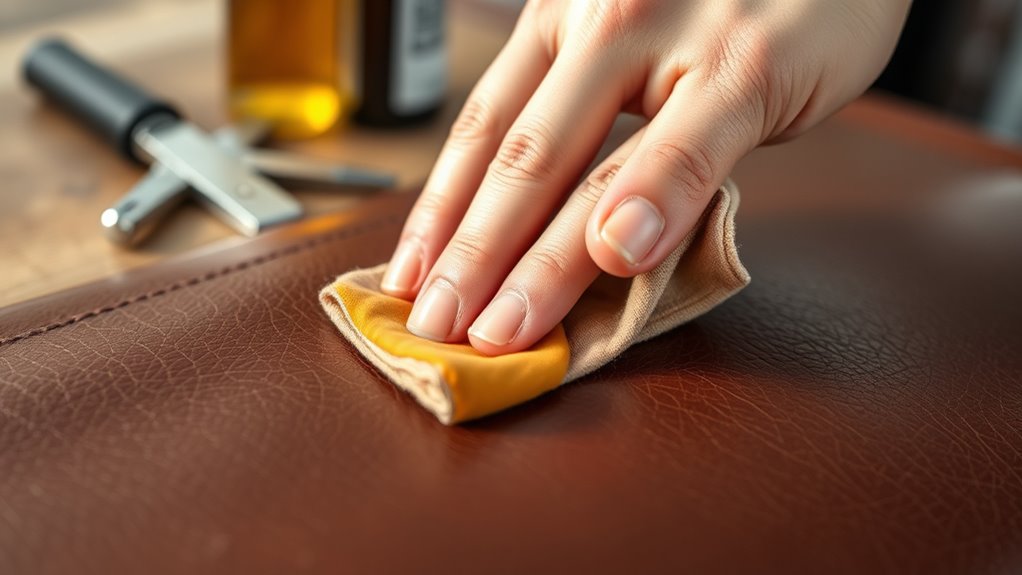
Choosing the right conditioner is essential to maintaining your leather’s appearance and durability. First, consider your leather finish—whether it’s matte, glossy, or satin—as different finishes require specific conditioners to avoid altering their look. Look for reputable conditioner brands that suit your leather type; some formulas are designed for smooth leather, while others work best on textured or exotic leathers. Always check the label to ensure the conditioner is compatible with your leather’s finish and does not contain harsh chemicals that could damage it. Testing a small, hidden area first helps prevent unwanted reactions. Selecting a high-quality conditioner tailored to your leather’s needs guarantees it stays supple, vibrant, and protected over time.
Applying Leather Conditioner Effectively
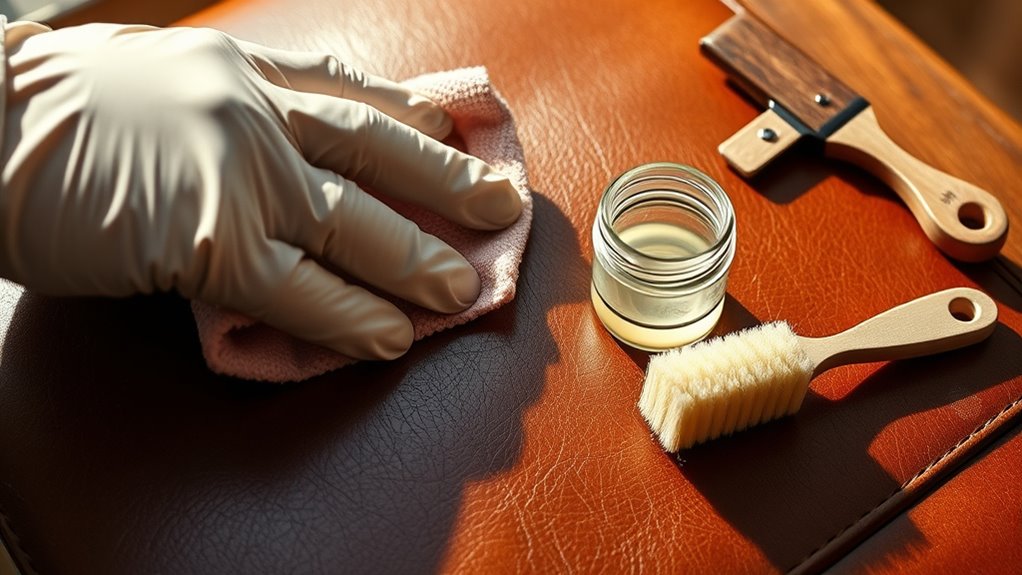
After selecting the right conditioner for your leather, applying it correctly guarantees ideal results. Use a soft cloth or sponge to spread the conditioner evenly, working in small sections. Pay attention to details like leather stitching, ensuring the conditioner reaches all crevices. For leather dyeing, avoid over-application to prevent uneven color shifts. Here’s a quick guide:
| Step | Tip | Focus Area |
|---|---|---|
| Even Application | Use circular motions | Entire surface |
| Let it Absorb | Leave for 15-20 minutes | Leather surface |
| Buff and Finish | Wipe excess with a clean cloth | Leather stitching |
This method keeps your leather supple, vibrant, and well-maintained. Proper application enhances longevity and preserves the leather’s natural beauty.
Tips for Maintaining Leather’s Appearance
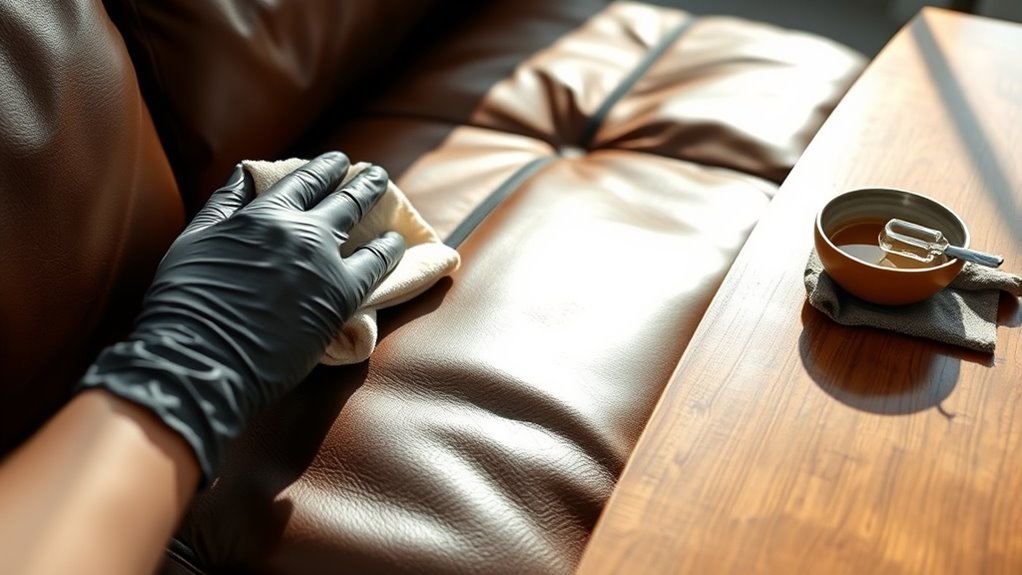
Maintaining your leather’s appearance requires regular care and attention to detail. To keep it looking its best, pay attention to the leather scent, which can fade over time without proper care. Store your leather items in a cool, dry place, preferably in breathable leather storage bags or covers, to prevent dust and moisture buildup. Avoid direct sunlight, which can cause fading and cracking. Clean your leather regularly with gentle products to maintain its natural luster and texture. When storing, ensure the items aren’t compressed or bent, as this can cause deformation. Proper storage and routine cleaning help preserve the leather’s vibrant appearance, softness, and scent, keeping your pieces looking fresh and inviting for years to come. Additionally, using appropriate cleaning and conditioning products will help sustain the leather’s durability and aesthetic appeal over time.
Avoiding Common Leather Care Mistakes
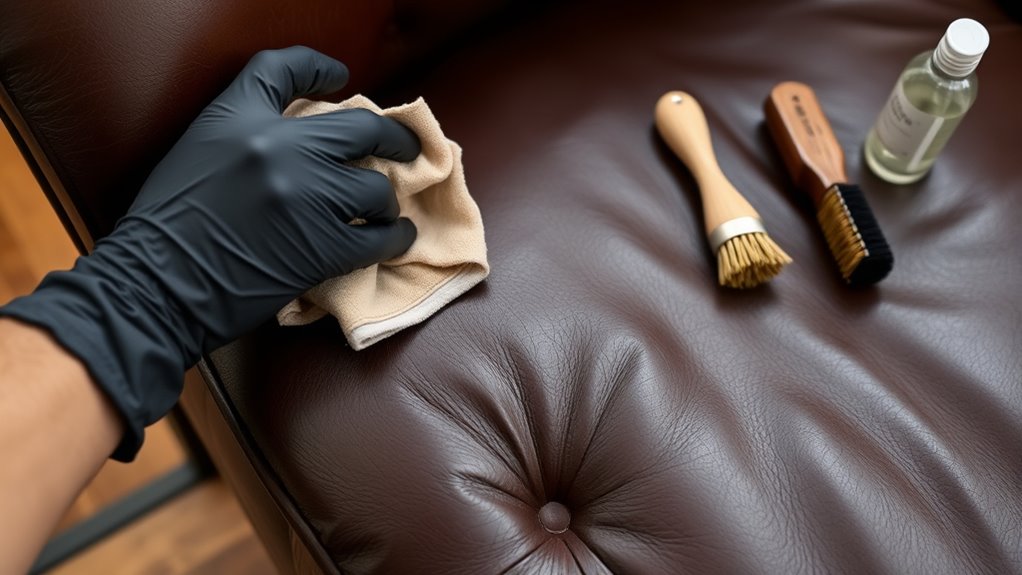
One of the most common mistakes in leather care is using harsh cleaning products or household chemicals that can damage the material. These can strip away natural oils and cause cracking. To avoid this, consider these tips:
- Never use ammonia or bleach-based cleaners on leather.
- Skip storing leather items in damp or direct sunlight, which can cause fading or warping.
- Be cautious with leather repair techniques; avoid DIY fixes that might worsen damage instead of restoring your item.
Proper leather storage helps maintain flexibility, while understanding repair techniques ensures you don’t inadvertently cause more harm. Using gentle, leather-specific products and seeking professional advice when needed can save your leather from unnecessary damage and prolong its lifespan.
Storing Leather Items Properly
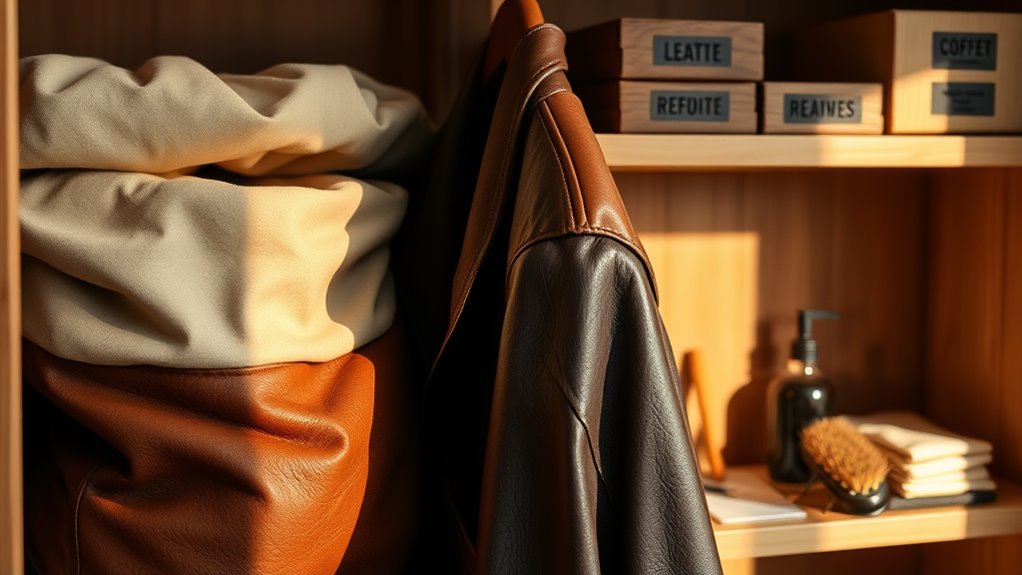
Proper storage of leather items is key to preserving their appearance and longevity. Choose suitable storage solutions like breathable bags or cloth covers to prevent dust buildup and allow airflow. Avoid plastic containers, which can trap moisture and cause mold or mildew. Climate considerations are essential; store leather in a cool, dry area away from direct sunlight, heat sources, and humidity. Extreme temperatures can cause leather to crack or warp. If possible, keep items in a space with consistent temperature and humidity levels. Use padded hangers for jackets or coats to maintain their shape, and lay flat items like wallets or belts to prevent creasing. Proper storage ensures your leather remains supple, vibrant, and durable over time. Moisture control is crucial in preventing damage caused by excess humidity.
Frequently Asked Questions
How Often Should I Clean and Condition My Leather Items?
You should clean and condition your leather items every 3 to 6 months for good leather maintenance. Regular cleaning helps remove dirt and oils, while conditioning keeps the leather soft and prevents cracks. If you use your leather items daily, consider more frequent cleaning. Pay attention to signs of wear or dirt buildup, and adapt your cleaning frequency accordingly. Proper care ensures your leather stays looking great and lasts longer.
Can Cleaning Products Damage Delicate or Vintage Leather?
Cleaning products can damage delicate or vintage leather if they aren’t safe for your specific item. Some products cause chemical reactions that weaken or discolor the leather, so always check product safety labels. You should test a small, hidden area first to see if any adverse reactions occur. Using gentle, specially formulated leather cleaners helps protect your vintage pieces, ensuring they stay beautiful and intact for years to come.
Is It Safe to Use Household Products on Leather?
Using household products on leather is like trying to fix a delicate painting with household glue—it’s risky for leather safety. Many common items contain chemicals that can damage or discolor your leather. Stick to specially formulated leather cleaners and conditioners to protect your investment. This way, you keep your leather looking its best without risking damage from unsuitable household products. Always prioritize leather safety over quick fixes.
How Do I Handle Stubborn Stains on Leather?
To handle stubborn stains on leather, start with gentle stain removal techniques like blotting with a damp cloth or using a mild soap solution. Avoid harsh chemicals that can damage the leather. After cleaning, apply a leather conditioner to prevent future stains and maintain your leather’s quality. Regularly practicing leather stain prevention, such as quick cleanup of spills, keeps your leather looking its best and easier to clean when stains do occur.
Can Leather Be Repaired if It Gets Damaged?
Think of your leather as a delicate masterpiece—you can often restore it. Yes, leather can be repaired if it gets damaged. Start with a damage assessment to identify the extent. Leather repair options like patching, filling, or professional restoration can bring your piece back to life. While minor scratches are fixable, deep tears might need expert attention, so don’t hesitate to seek professional help for the best results.
Conclusion
With a little care, your leather can shine like a polished mirror, aging gracefully like fine wine. Think of cleaning and conditioning as tending a delicate garden—patience and attention will keep it lush and vibrant. By following these steps, you’ll turn your leather into a timeless treasure, its beauty forever echoing your dedication. Embrace the process, and watch your leather transform into a stunning masterpiece that tells your story.




